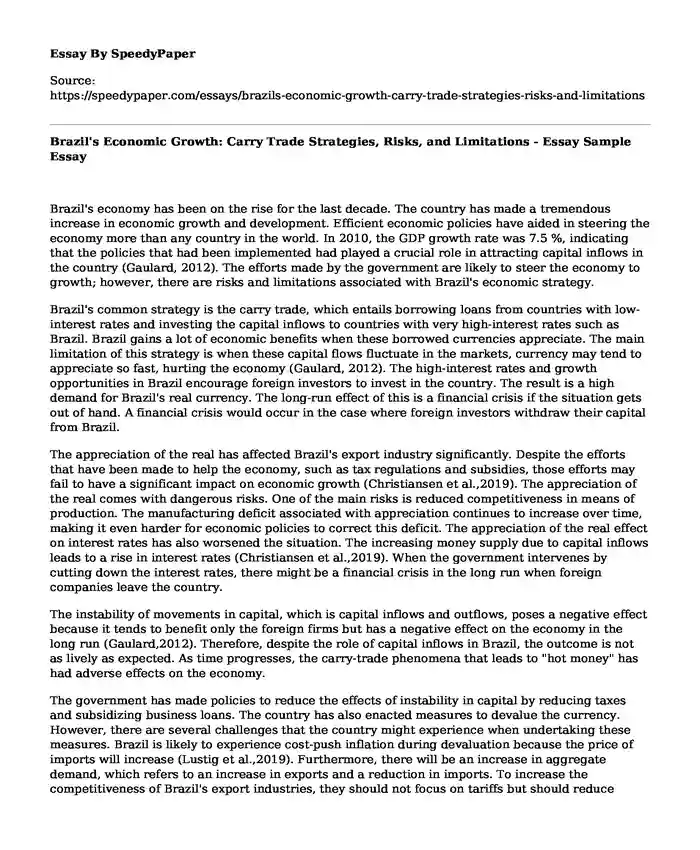
| Type of paper: | Essay |
| Categories: | Economics Government |
| Pages: | 3 |
| Wordcount: | 669 words |
Brazil's economy has been on the rise for the last decade. The country has made a tremendous increase in economic growth and development. Efficient economic policies have aided in steering the economy more than any country in the world. In 2010, the GDP growth rate was 7.5 %, indicating that the policies that had been implemented had played a crucial role in attracting capital inflows in the country (Gaulard, 2012). The efforts made by the government are likely to steer the economy to growth; however, there are risks and limitations associated with Brazil's economic strategy.
Brazil's common strategy is the carry trade, which entails borrowing loans from countries with low-interest rates and investing the capital inflows to countries with very high-interest rates such as Brazil. Brazil gains a lot of economic benefits when these borrowed currencies appreciate. The main limitation of this strategy is when these capital flows fluctuate in the markets, currency may tend to appreciate so fast, hurting the economy (Gaulard, 2012). The high-interest rates and growth opportunities in Brazil encourage foreign investors to invest in the country. The result is a high demand for Brazil's real currency. The long-run effect of this is a financial crisis if the situation gets out of hand. A financial crisis would occur in the case where foreign investors withdraw their capital from Brazil.
The appreciation of the real has affected Brazil's export industry significantly. Despite the efforts that have been made to help the economy, such as tax regulations and subsidies, those efforts may fail to have a significant impact on economic growth (Christiansen et al.,2019). The appreciation of the real comes with dangerous risks. One of the main risks is reduced competitiveness in means of production. The manufacturing deficit associated with appreciation continues to increase over time, making it even harder for economic policies to correct this deficit. The appreciation of the real effect on interest rates has also worsened the situation. The increasing money supply due to capital inflows leads to a rise in interest rates (Christiansen et al.,2019). When the government intervenes by cutting down the interest rates, there might be a financial crisis in the long run when foreign companies leave the country.
The instability of movements in capital, which is capital inflows and outflows, poses a negative effect because it tends to benefit only the foreign firms but has a negative effect on the economy in the long run (Gaulard,2012). Therefore, despite the role of capital inflows in Brazil, the outcome is not as lively as expected. As time progresses, the carry-trade phenomena that leads to "hot money" has had adverse effects on the economy.
The government has made policies to reduce the effects of instability in capital by reducing taxes and subsidizing business loans. The country has also enacted measures to devalue the currency. However, there are several challenges that the country might experience when undertaking these measures. Brazil is likely to experience cost-push inflation during devaluation because the price of imports will increase (Lustig et al.,2019). Furthermore, there will be an increase in aggregate demand, which refers to an increase in exports and a reduction in imports. To increase the competitiveness of Brazil's export industries, they should not focus on tariffs but should reduce budget deficits to achieve economic growth.
In conclusion, Brazil's strategy of attracting capital inflows has had both positive and negative impacts. Positively, it has led to an increase in standards of living among Brazilians. However, it has also put the country's economy under huge risks, which could lead to a financial crisis. Therefore, the Brazilian government should put emphasis on coming up with appropriate solutions to protect the economy.
References
Christiansen, C., Ranaldo, A., &Soderlind, P. (2011). The time-varying systematic risk of carrying trade strategies. Journal of Financial and Quantitative Analysis,1107-1125.http://www.jstor.org/stable/23018430
Gaulard, M. (2012). The "hot money "phenomenon in Brazil. Brazilian Journal of Political Economy,32(3),367-388.10.1590/S0101-3157201200030002
Lustig, H., Stathopoulus, A., &Verdelhan, A. (2019). The term structure of currency carries trade risk premia. American Economic Review, 109 (12),4142-77.10.1257/aer.20180098
Cite this page
Brazil's Economic Growth: Carry Trade Strategies, Risks, and Limitations - Essay Sample. (2023, Dec 26). Retrieved from https://speedypaper.net/essays/brazils-economic-growth-carry-trade-strategies-risks-and-limitations
Request Removal
If you are the original author of this essay and no longer wish to have it published on the SpeedyPaper website, please click below to request its removal:
- NATO and Libya - Free Essay on Humanitarian Intervention
- Essay Example on Transport and Development
- Essay Example on Overpopulation in Mexico City
- Free Essay Example: Prime Interest Rate
- Paper Example. Response to Questions on the Dust Blow
- Essay Sample on The Concept of Globalization
- Leadership & Management: What's the Difference? - Essay Sample
Popular categories




